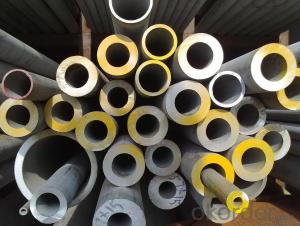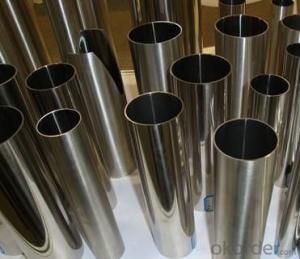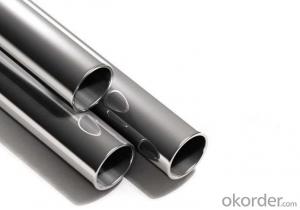316 Stainless Steel Pipe
- Loading Port:
- China main port
- Payment Terms:
- TT OR LC
- Min Order Qty:
- 5 m.t.
- Supply Capability:
- 100000 m.t./month
OKorder Service Pledge
OKorder Financial Service
You Might Also Like
Item specifice
SPECIFICATION
Stainless Steel Pipe:
1. 201, 202, 301, 304, 316L, 430, etc
2. OD: 6mm-159mm
3. Thickness: 0.25mm-3.5mm
4. Finish: Mirror, Satin, Hairline
316 STAINLESS STEEL PIPE:
Name | 316 Stainless steel pipe | |||||
Standard | ASTM A554,ASTM A312 | |||||
Material Grade | 201,202,304,316,316L,430 | |||||
Main Material
| a) 201 (Ni0.8%-1%) b) 202 (Ni: 3.0%-4.0%) d) 316 (Ni: 10% Cr: 18%) | |||||
Size Range | 139mm-1600mm ETC. | |||||
Thickness | 0.5-30mm | |||||
Length | 6m or as customers' request | |||||
Tolerance | a) Outer Diameter: +/- 0.2mm | |||||
b) Thickness: +/- 0.02mm | ||||||
c) Length: +/- 5mm | ||||||
Surface | 180G, 320G Satin/Hairline 400G, 600G Mirror finish | |||||
Application | handrail,railing, staircase, weldmesh screen,door,window, balcony,fence,bench,furniture,etc | |||||
Test | Squash test, extended test, water pressure test, crystal rot test, heat treatment, NDT | |||||
Chemical Composition of Material | 201 | 202 | 304 | 316L | 430 | |
C | ≤0.15 | ≤0.15 | ≤0.08 | ≤0.035 | ≤0.12 | |
Si | ≤1.00 | ≤1.00 | ≤1.00 | ≤1.00 | ≤1.00 | |
Mn | 5.5-7.5 | 7.5-10 | ≤2.00 | ≤2.00 | ≤1.00 | |
P | ≤0.06 | ≤0.06 | ≤0.045 | ≤0.045 | ≤0.040 | |
S | ≤0.03 | ≤0.03 | ≤0.030 | ≤0.030 | ≤0.030 | |
Cr | 13-15 | 14-17 | 18-20 | 16-18 | 16-18 | |
Ni | 0.7-1.1 | 3.5-4.5 | 8-10.5 | 10-14 | ||
Mo | 2.0-3.0 | |||||
Mechanical Property | Material Item | 201 | 202 | 304 | 316 | |
Tensile Strength | ≥535 | ≥520 | ≥520 | ≥520 | ||
Yield Strength | ≥245 | ≥205 | ≥205 | ≥205 | ||
Extension | ≥30% | ≥30% | ≥35% | ≥35% | ||
Hardness (HV) | <105< span=""> | <100< span=""> | <90< span=""> | <90 | ||

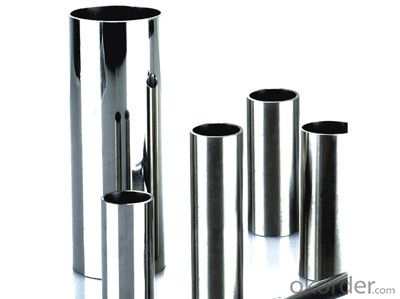
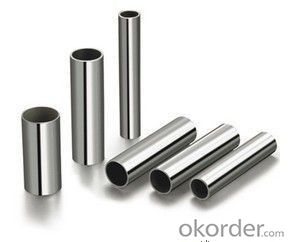
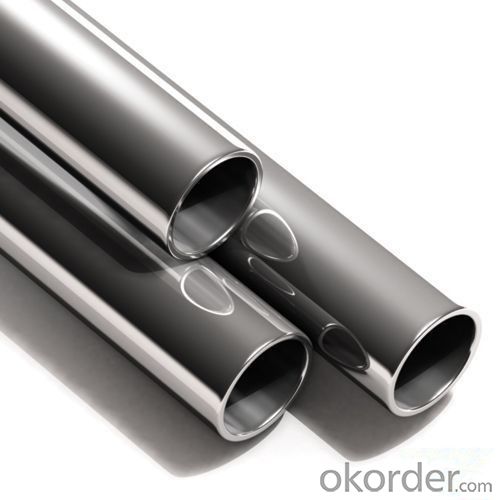
- Q:Can stainless steel pipes be used for hydroelectric power plants?
- Yes, stainless steel pipes can be used for hydroelectric power plants. Stainless steel is commonly used in hydroelectric power plants due to its excellent corrosion resistance, high strength, and durability. It can withstand the harsh operating conditions, including water pressure, turbulence, and exposure to moisture, making it a suitable material for piping systems in hydroelectric power plants.
- Q:Can stainless steel pipes be used for air pollution control systems?
- Yes, stainless steel pipes can be used for air pollution control systems. Stainless steel is a highly durable and corrosion-resistant material, making it suitable for handling harsh environments and corrosive gases that are commonly found in air pollution control systems. Stainless steel pipes also have the advantage of being able to withstand high temperatures, allowing them to be used in applications where thermal resistance is required. Additionally, stainless steel is known for its hygiene properties, making it an ideal choice for industries that require clean and sterile air handling. Overall, stainless steel pipes are a popular and reliable choice for air pollution control systems due to their strength, durability, corrosion resistance, and ability to handle high temperatures.
- Q:Can stainless steel pipes be used for cryogenic applications?
- Yes, stainless steel pipes can be used for cryogenic applications. Stainless steel is known for its excellent low-temperature properties, including good strength, ductility, and resistance to corrosion. These properties make stainless steel pipes suitable for transporting and storing cryogenic fluids such as liquid nitrogen, oxygen, or argon. The high strength-to-weight ratio of stainless steel allows for the construction of lightweight and durable cryogenic systems. Additionally, stainless steel pipes can withstand the extreme temperature gradients and thermal stresses commonly encountered in cryogenic applications. However, it is important to choose the appropriate grade of stainless steel that is specifically designed for cryogenic service to ensure optimal performance and safety.
- Q:Can stainless steel pipes be used for wastewater treatment plants?
- Yes, stainless steel pipes can be used for wastewater treatment plants. Stainless steel is a highly durable and corrosion-resistant material, making it an ideal choice for applications in harsh environments such as wastewater treatment plants. The resistance to corrosion helps to prevent leaks and minimize maintenance, ensuring a longer lifespan for the pipes. Additionally, stainless steel pipes are also hygienic and easy to clean, which is crucial in wastewater treatment plants where cleanliness and sanitation are of utmost importance. Overall, stainless steel pipes are a reliable and efficient option for transporting wastewater in treatment plants.
- Q:What is the difference between ferritic and austenitic stainless steel pipes?
- Ferritic and austenitic stainless steel pipes differ primarily in their microstructure and composition, resulting in distinct properties and applications. Ferritic stainless steel pipes are characterized by a ferrite microstructure, which is a body-centered cubic crystal structure. They contain high levels of chromium (typically around 10-30%) and low levels of carbon. Due to their low carbon content, ferritic stainless steel pipes have excellent corrosion resistance but are prone to sensitization and intergranular corrosion at high temperatures. They also possess good durability, heat resistance, and magnetic properties, making them suitable for applications such as automotive exhaust systems, architectural structures, and heat exchangers. On the other hand, austenitic stainless steel pipes have an austenite microstructure, which is a face-centered cubic crystal structure. They contain high levels of chromium (typically around 16-26%) and nickel (usually 6-22%), along with low carbon content. Austenitic stainless steel pipes exhibit superior corrosion resistance, even in highly aggressive environments. Their non-magnetic nature, excellent ductility, and high toughness make them ideal for various industries, including chemical processing, food and beverage, pharmaceuticals, and medical equipment manufacturing. Austenitic stainless steel pipes are also less prone to sensitization and intergranular corrosion compared to ferritic stainless steel pipes. In summary, ferritic stainless steel pipes have a ferrite microstructure, good corrosion resistance, and magnetic properties, while austenitic stainless steel pipes have an austenite microstructure, superior corrosion resistance, non-magnetic properties, and enhanced mechanical properties. The choice between ferritic and austenitic stainless steel pipes depends on the specific application, desired properties, and environmental conditions.
- Q:Are stainless steel pipes suitable for brewing systems?
- Stainless steel pipes prove to be an exceptional choice for brewing systems. Their remarkable corrosion resistance, hygienic attributes, and durability make stainless steel the most preferred material for brewing equipment. When it comes to brewing, stainless steel pipes demonstrate their superiority by not reacting with the acidic elements present in the process. This ensures that the beer remains free from any undesirable flavors or contaminants. Moreover, stainless steel pipes offer the advantage of easy cleaning and maintenance, making them a perfect fit for the brewing process. In summary, stainless steel pipes guarantee the production of exceptional beer by providing a dependable and long-lasting solution for brewing systems, ensuring high-quality and uncontaminated results.
- Q:How do you calculate the pipe length required for a specific application?
- To calculate the pipe length required for a specific application, you need to consider factors such as the flow rate, pressure drop, pipe material, and the type of fluid being transported. By using equations and formulas specific to fluid dynamics, you can determine the appropriate pipe length needed to achieve the desired flow and pressure conditions. Additionally, factors like pipe fittings, bends, and elbows also need to be taken into account when calculating the overall pipe length required.
- Q:Can stainless steel pipes be used for wastewater treatment systems?
- Yes, stainless steel pipes can be used for wastewater treatment systems. Stainless steel is highly resistant to corrosion, making it a suitable material for handling corrosive wastewater. It is also durable, long-lasting, and easy to maintain, making it an ideal choice for wastewater treatment systems.
- Q:Can stainless steel pipes be used for hygienic applications?
- Yes, stainless steel pipes can be used for hygienic applications. Stainless steel is a highly durable and corrosion-resistant material that is commonly used in industries where hygiene is of utmost importance, such as food and beverage, pharmaceutical, and biotechnology sectors. Stainless steel pipes have a smooth surface that prevents the growth of bacteria and other microorganisms, making them suitable for applications where cleanliness is crucial. They are also easy to clean and maintain, as the smooth surface allows for efficient and thorough cleaning, reducing the risk of contamination. Moreover, stainless steel pipes are non-reactive and do not release any harmful substances into the products being transported. This makes them ideal for applications where sanitary conditions are essential, such as in the production and transportation of food, beverages, and pharmaceuticals. Additionally, stainless steel pipes have excellent resistance to high temperatures, chemicals, and corrosion, ensuring the integrity of the system and preventing any contamination or leaks. They are also highly durable and can withstand harsh operating conditions, making them a reliable choice for hygienic applications. In conclusion, stainless steel pipes are suitable for hygienic applications due to their durability, corrosion resistance, smooth surface, ease of cleaning, and non-reactivity. They provide a reliable and sanitary solution for industries where hygiene is a top priority.
- Q:What are the different types of stainless steel pipe couplings?
- There are several different types of stainless steel pipe couplings available in the market, each offering unique features and functionalities. Some of the common types include: 1. Compression couplings: These couplings are designed to provide a tight and secure connection by compressing the pipe ends together using a compression nut. They are easy to install and suitable for both rigid and flexible pipe systems. 2. Flanged couplings: These couplings have flanges on both ends, which can be bolted together to create a strong and leak-proof connection. Flanged couplings are commonly used in industrial applications where high pressures and temperatures are involved. 3. Grooved couplings: These couplings consist of two segments that grip the pipe ends when tightened, creating a reliable and flexible connection. They are often used in fire protection systems and HVAC applications due to their ease of installation and ability to withstand vibration and movement. 4. Threaded couplings: As the name suggests, these couplings have threads on the inside, allowing them to be screwed onto the pipe ends. They are commonly used in low-pressure applications and are easy to assemble and disassemble. 5. Quick connect couplings: These couplings feature a quick-connect mechanism that allows for easy and rapid installation without the need for tools or additional components. They are often used in plumbing and irrigation systems. 6. Welded couplings: These couplings require the pipe ends to be welded together to create a permanent and robust connection. They are commonly used in high-pressure and high-temperature applications where a strong joint is essential. It is important to select the appropriate type of stainless steel pipe coupling based on the specific requirements of the application, such as the operating conditions, pipe material, and system design. Consulting with a professional or referring to industry standards can help ensure the right choice is made.
1. Manufacturer Overview |
|
|---|---|
| Location | |
| Year Established | |
| Annual Output Value | |
| Main Markets | |
| Company Certifications | |
2. Manufacturer Certificates |
|
|---|---|
| a) Certification Name | |
| Range | |
| Reference | |
| Validity Period | |
3. Manufacturer Capability |
|
|---|---|
| a)Trade Capacity | |
| Nearest Port | |
| Export Percentage | |
| No.of Employees in Trade Department | |
| Language Spoken: | |
| b)Factory Information | |
| Factory Size: | |
| No. of Production Lines | |
| Contract Manufacturing | |
| Product Price Range | |
Send your message to us
316 Stainless Steel Pipe
- Loading Port:
- China main port
- Payment Terms:
- TT OR LC
- Min Order Qty:
- 5 m.t.
- Supply Capability:
- 100000 m.t./month
OKorder Service Pledge
OKorder Financial Service
Similar products
New products
Hot products
Hot Searches
Related keywords
